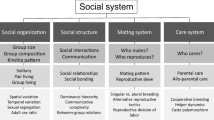Summary
Grouping of female Mus musculus resulted in an increase in mean estrous cycle length from 4 to 12 days, yet some short cycles were still observed. Short cycles were attributed to certain females who consistently maintained a short cycling pattern as well as females who exhibited both short and long cycles. Upon breeding, females that continued to show a short cycle when grouped produced and weaned more young than females with suppressed cycles. No differences in mean weaning weight or sex ratio of the litters was observed. The ecological and evolutionary implications of these findings are discussed.
Similar content being viewed by others
References
Champlin AK (1971) Suppression of oestrous in grouped mice: the effects of various densities and the possible nature of the stimulus. J Reprod Fertil 27:233–241
Christian JC, Davis DE (1964) Endocrines, behavior and population. Science 146:1550–1560
Franks P, Lenington S (1986) Behav Ecol Sociobiol
Krebs CJ (1978) A review of the Chitty Hypothesis of population regulation. Can J Zool 56:2463–2480
Lamond DR (1959) Effect of stimulation derived from other animals of the same species on oestrous cycles in mice. J Endocrinol 18:343–349
Lloyd JA (1975) Social structure and reproduction in two freelygrowing populations of house mice (Mus musculus L.). Anim Behav 23:413–424
Lloyd JA, Christian JC (1969) Reproductive activity of individual females in three experimental freely growing populations of house mice (Mus musculus). J Mammal 50:49–59
Ryan KD, Schwartz NB (1977) Grouped female mice: demonstration of pseudopregnancy. Biol Reprod 17:578–583
Sokal RR, Rohlf JF (1969) Biometry. W.H. Freeman and Co., San Francisco
Tamarin RH (ed) (1978) Population regulation. Dowden, Hutchinson and Ross, Inc., Stroudsburg, PA
Lee S van der, Boot LM (1955) Spontaneous pseudopregnancy in mice. I. Acta Physiol Pharmacol Neer 4:442–444
Lee S van der, Boot LM (1956) Spontaneous pseudopregnancy in mice. II. Acta Physiol Pharmacol Neerl 5:213–214
Saal F vom (1979) Prenatal exposure to androgen influences morphology and aggressive behavior of male and female mice. Horm Behav 12:1–11
Saal F vom (1981) Variation in phenotype due to random intrauterine positioning of male and female fetuses in rodents. J Reprod Fert 62:633–650
Saal F vom (1983) Models of early hormonal effects on intrasex aggression in mice. In: Svare B (ed), Hormone and aggressive behavior, New York: Plenum Press, pp 197–222
Saal F vom, Bronson FH (1978) In utero proximity of female mouse fetuses to males: effect on reproductive performance during later life. Biol Reprod 19:842–853
Whitten WK (1959) Occurrence of anoestrous in mice caged in groups. J Endocrinol 18:102–107
Author information
Authors and Affiliations
Rights and permissions
About this article
Cite this article
Massey, A. Variable responses to high density of female Mus musculus: A merger of two population regulation hypotheses. Oecologia 69, 140–143 (1986). https://doi.org/10.1007/BF00399050
Received:
Issue Date:
DOI: https://doi.org/10.1007/BF00399050




